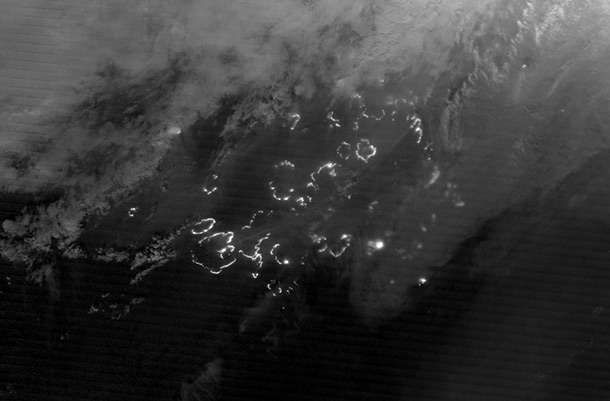Create a free profile to get unlimited access to exclusive videos, sweepstakes, and more!
Nighttime view of Russian wildfires from space

Wildfires are burning across the United States right now, but we have some very unwelcome company: for months there have been raging fires in Russia as well, conflagrations burning up vast swaths of the forests there.
The Suomi National Polar-orbiting Partnership satellite has a camera on board that can detect very low levels of visible and infrared red light. It's sensitive enough to be able to see wildfires at night, and took this eerie image on August 3, 2012:
The fires are the bright curved lines, and you can also see milky smoke to the right. To give you a sense of scale, the largest of these fires is over 50 km (30 miles) across! That's so huge I have a hard time comprehending it; the large High Park fire in Colorado earlier this year was far smaller.
Cameras like this one on Suomi-NPP help gauge the size and location of fires, and after the worst is over they can show the extent of the damage (especially when coupled with other satellite imagery). These are critical tools in our understanding of natural disasters, and can help save lives in the future.
I want to show you another picture, too. Last week when I was flying home from a wonderful visit to Portland, Oregon to give a talk, I noticed something odd out my airplane window. After a minute or two, it became clear that what I was seeing was a big wildfire:

There were several small fires generating smoke (to the left of the big plume), and then a very big pyrocumulus (fire-generated) cloud. The plume from the combined fires blew for dozens of kilometers downwind; you can see ripples in the plume as it flowed over the local topography.
I wasn't sure where we were exactly when I took the picture, so when I got home I looked up wildfires in Oregon, Idaho, and Wyoming. I was amazed to see that there were so many fires I couldn't pin down which one I was seeing. That's how bad this summer is; it's been so hot and dry in the US that fires are common enough to become hard to identify from the air. If you do happen to know which one I saw, please let me know.
I generally say that it's hard to pin specific weather events on global warming, but that what we're seeing these days is consistent with what we expect of a planet getting hotter. That's true, but it's becoming more clear that many of these events are at the very least helped along by our changing climate. I'll be writing more about that very soon. Stay tuned.
Image credit: NASA Earth Observatory image by Jesse Allen and Robert Simmon.
Related Posts:
- New satellite gets INSANELY hi-res view of the Earth
- Pyrocumulus cloud
- The scars of a Colorado fire
- Huge glacier calves off Greenland
- Boulder wildfire



























